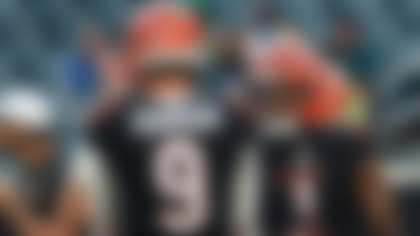Over the past few seasons, I have been identifying overperforming and underperforming units using a model I created that seeks to measure the difference between preseason expectations and actual game outputs. In order to come up with the preseason expectation rankings, I project each team's win share by unit. Preseason projections are more subjective than postseason win-share metrics, as the preseason rankings blend more certain factors (veteran personnel, free-agent signings, salaries) with less certain clues (how the new draft class is likely to impact production, how injuries will come into play). Actual game outputs are calculated based on the unit's actual win share in each game played. (Reminder: My win-share figure is defined as the measurement of how each player, position group and side of the ball impacts a team's ability to earn first downs and touchdowns, as related to wins. And yes, these can be negative.)
The whole point is to apply structure with as little bias as possible, in order to interpret on-field production with the situations that led to specific outcomes -- and then, for the purposes of this exercise, compare the final figures to expectations. The goal here is to identify the units with the biggest difference between preseason forecast and postseason win share.
So, without further ado, let's get to the meat of this file: The five most overperforming and underperforming units of the 2021 NFL season. The strengths and shortcomings highlighted below may end up being big factors in teams' 2022 offseason approaches, decisions and strategies.
OVERPERFORMERS
Preseason win-share ranking: 26th. Final ranking: 15th.
There was plenty of uncertainty around the QB position back when the Patriots decided to install a rookie starter, prompting the release of veteran Cam Newton. But Mac Jones -- who took all but 14 pass attempts for the team this season -- far exceeded the preseason ranking given to this unit. The 15th overall selection in last April's draft (and the fifth QB chosen in Round 1) not only fared as the best rookie passer this season, but he also ranked in the top five in the NFL in several metrics, driving his value of 15th to finish the season.
Per Next Gen Stats, Jones had a 71.4 completion percentage against two-safety shells, second in the league behind Kyler Murray’s 72.8. On quick passes, he had a 77.4 completion percentage, ranking fifth, and his 74.4 completion percentage on play-action was second only to Jimmy Garoppolo (75.4%).
Preseason win-share ranking: 15th. Final ranking: 7th.
That forecasted preseason ranking of just above average actually flagged as a bigger concern than one might think -- remember, with both Patrick Mahomes and Justin Herbert in the AFC West, teams in that division need to be especially mindful of stopping the pass.
What did Las Vegas end up doing? Setting records for the NGS era (going back to the 2016 season). The Raiders were the first team in that span to produce two of the top four individual players in terms of QB pressures (Maxx Crosby ranked first with 82, Yannick Ngakoue was third with 71). They were also the first team so far to rank first in pressure rate (33.6%) despite ranking last in blitz rate (14.4%). In other words, they got it done without rushing more than four. And even when they did blitz, they made their way into the record books again, setting a single-season high in pressure rate when blitzing (52.2%).
Preseason win-share ranking: 27th. Final ranking: 14th.
Before we dig in here, let's talk about defensive pressure. I realize this might seem similar to pass rush, but I added defensive pressure as its own metric to reflect how the pass rush and pass coverage must work together to effectively limit passing opportunities. Back in August, my models projected Cincinnati's defensive pressure unit to be among the NFL's least effective. But my models did not accurately forecast how well pass rusher Trey Hendrickson would perform on passing downs specifically, in tandem with the coverage capabilities of corners Chidobe Awuzie and Mike Hilton, safety Jessie Bates and even linebacker Logan Wilson.
This is a great case study for why I created this metric, as it reveals a summary statistic that can be more illustrative than isolating the defensive front and back separately. Up front, NGS shows that Hendrickson had a 19.4 percent pressure rate, the best individual rate in the NFL. As a unit, the front ranked sixth-best in sack rate when blitzing (10.2%) and seventh-best in pressure rate when not blitzing (28.4%). Combined with Cincy's offensive output, the final ranking here of 14th helps explain how the Bengals made it to the Super Bowl.
Preseason win-share ranking: 27th. Final ranking: 18th.
In the wake of Cam Akers' Achilles tear in July, the Rams sent a pair of Day 3 draft picks to the Patriots in exchange for Sony Michel. Seeing how the Rams' had little pre-existing depth beyond Darrell Henderson -- and Michel was joining a brand new team just a few weeks before kickoff -- Los Angeles' RB win-share forecast plummeted down toward the bottom of the league. However, Michel (845 yards rushing) and Henderson (688) proved to be an effective duo, helping the Rams win a highly competitive NFC West. Next Gen Stats show that Rams backs averaged 4.7 yards per rush against neutral boxes (ones with seven defenders), ranking 10th-best. They also had a 45.8 percent success rate on rushes inside the tackles, ranking sixth-best.
I also have to add this: I'm glad I only did this analysis through the end of regular season, as Akers returning from an injury of this magnitude for the postseason is such an outlier in terms of comparable data. I did take a quick peek with computer vision, and his speed and power (ability to maintain speed when contacted) does not track like any other player in my sample who had returned from an Achilles tear. Simply put, he's an incredible specimen.
Preseason win-share ranking: 23rd. Final ranking: 16th.
Ahead of the season, my models were high on safety Justin Simmons and liked the prospect of rookie Patrick Surtain II after a learning curve, but were not high on the free-agent additions of Ronald Darby or Kyle Fuller, thus explaining that initial No. 23 ranking. But the Broncos outperformed that mark in a difficult environment.
As noted above in the Raiders blurb, stopping the pass -- particularly the deep pass -- is especially crucial in the AFC West, and it typically takes a joint effort from the front and back ends of a defense. But even when Denver's front was unable to get pressure on the opposing quarterback, the Broncos' secondary allowed just a 65.4 completion percentage (third in the NFL) and 89.9 passer rating (fifth). That takes some sticky coverage. Denver was impressive on throws outside the numbers, too, yielding an 80.5 passer rating and 6.3 yards per attempt.
UNDERPERFORMERS
Preseason win-share ranking: 1st. Final ranking: 15th.
Many people, myself included, projected Washington to top the NFC East for a second straight season, based in large part on an incredibly talented defensive line that started four first-round selections, including 2020 Defensive Rookie of the Year Chase Young. This was, in fact, my top-rated defensive front in the preseason. So how did it drop to the middle of the pack by season's end?
Well, Young's season-ending injury in mid-November certainly didn't help, but he hadn't lived up to his preseason billing to that point anyway, recording just 1.5 sacks in nine games. And Young wasn't alone when it came to disappointing play. NGS shows that Washington allowed 1.6 yards per rush before contact this season (the eighth-worst figure in the league) and only had a 6.0 percent sack rate (19th).
Preseason win-share ranking: 23rd. Final ranking: 30th.
With the splashy, expensive free-agent signing of Kenny Golladay, the first-round selection of Kadarius Toney and even the addition of speed merchant John Ross, all signs were pointing toward an uptick in production from the position group ahead of the season. That did not play out.
According to Next Gen Stats, New York receivers earned just 2.5 yards of target separation, the lowest mark in the NFL. Giants WRs posted the fifth-worst season total for yards after the catch over expected (29 positive yards) and the seventh-worst catch rate over expected (-4.8 percent).
Preseason win-share ranking: 17th. Final ranking: 26th.
With more development from the 2020 draft class and the veteran addition of Patrick Peterson, the unit projected to rise toward the middle of the league. But over the course of the season, Vikings defensive backs allowed 20 touchdowns on passes of 10-plus air yards, tied with Washington for the most. Minnesota's plus-5.9 percent completion rate over expected on passes of 10-plus air yards ranked third-worst and the 110.6 passer rating allowed on such passes was fifth-worst.
It's also not great when a starter, Bashaud Breeland, gets cut in December. Oh, and Pro Football Focus had Mackensie Alexander posting the worst slot-coverage grade in the NFL.
Preseason win-share ranking: 14th. Final ranking: 23rd.
My models liked the second-round selection of offensive tackle Teven Jenkins to support rookie QB Justin Fields' style of play, even taking into account the unknowns around Jenkins' health (he underwent back surgery in August and ended up appearing in six games late in the season) and the status of the Bears' QB position (I projected Fields and veteran Andy Dalton to each start eight games) when win-share was calculated. Adding veteran tackle Jason Peters was a driver of projected success, as well.
However, the Bears' offensive line slipped. Next Gen Stats shows that Fields was sacked at a rate of 11.8 percent, the highest in a season during the NGS era (since 2016). He was also under pressure on 36.6 percent of dropbacks, which was the second-highest rate this season (only Teddy Bridgewater was under more pressure at 37.4 percent). Some of the sacks and pressure can be attributed to Fields' style of play and the plays that were called. Ultimately, though, securing the right O-line for Fields forecasts to be a huge factor in his success going forward.
Preseason win-share ranking: 18th. Final ranking: 28th.
It wasn't just the loss of receiver Odell Beckham Jr., who was released midseason, that drove Cleveland's underperformance here. The Browns' pass catchers did not need to function like the Bills' or Bengals' groups to fulfill this projected win-share; rather, they just needed to complement the run-first offense, by creating additional opportunities to run or through the strategic use of shorter passes. That did not happen.
NGS shows that the Browns only earned seven touchdowns on passes outside the numbers this season (tied for third-fewest in the NFL), posted a -7.1 catch rate over expected on passes of 10-plus air yards (second-lowest) and earned just 11.2 yards per reception versus press coverage (only the Lions earned fewer). As for computer vision, on plays of second-and-6-or-more, defenses were, on average, 1.4 yards further away from Cleveland's pass-catching options beyond the line to gain than they were from pass catchers in the same situation from all other teams, potentially implying that opposing defenses were minding the run. Pass catchers who can draw defenders into coverage could help create more space for the run and short games, helping to keep third downs more manageable.
Follow Cynthia Frelund on Twitter.






















